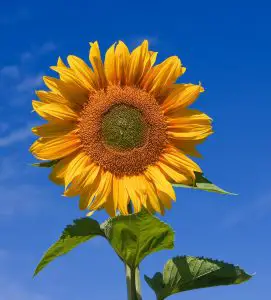Introduction
Quick Navigation
Sunflowers are biologically classified in kingdom Plantae; family Asteraceae; and order Asterals. They are scientifically known as Heliantus. Sunflowers are native to North America that is, Canada and the United States. Also, they are prominent native to Ukraine and Russia. In addition, they thrive well in central and southern America such as Mexico. Sunflowers bloom in summer months. Their native environments include dry, wide, open space such as the prairies, plains, and meadow environments. They are perennial plants although may be grown annually.
See also reference
Globally, Ukraine is known as world’s largest producer of sunflowers, followed by Russia. The United States ranks tenth in the production of sunflowers, being grown in large numbers in northern and southern Dakota and Minnesota. Sunflowers are known as turnesol in France.
Climatic and Soil Conditions for Sunflowers
In general, sunflowers are classified into two: oil-seed sunflowers, and non-oil sunflowers. However, the oil-seed sunflowers constitute a higher proportion. Sunflowers grow best in full, bright sun; and they require evenly moist, well-drained soil for optimal performance. Usually, the soil temperature should range between 70 and 85 degrees Fahrenheit. The ideal soil temperature for planting ranges between 60 and 70 degrees Fahrenheit. They are usually planted in spring when the soil temperature is slightly warm.
Cultivating sunflowers is quite easy. The plants are heat-tolerant, and pest-resistant to some extent. They also grow quite fast. Taller sunflowers have tap roots that go far into the soil in search of water, surrounded by a thick net of fibrous roots just below the soil. While growing, sunflowers require at least 6 hours of sunlight per day. Sunflowers have natural ability to exterminate other plants that grow close to them by means of allelopathic, a poisonous substance that exudes from them. Pole beans and potatoes are negatively affected by sunflowers, and therefore cannot grow close to them on the same area of land. Their flowers have male and female sex organs and can self-pollinate when visited by insects or by other means to produce seeds.
Types of Sunflower
Sunflowers are very numerous in kinds. There are over 70 species of these beautiful flowers all over the world. The high diversity of this group of plants may not be unconnected to their tolerance and adaptability to many environments and habitats. Some species of sunflowers are enumerated as follows:
Common Sunflowers. They are scientifically known as Helianthus annuus. They usually grow tall with oval or hearth-shaped flowers; and their leaves and stems are usually coarse and hairy. They are usually grown for their edible oil and fruits. It is also commonly grown by farmers for birds’ food, livestock forage, and as industrial ornamental flowers. And they grow fast.
Maximilian sunflowers. This species of sunflowers, known scientifically as Helianthus maximiliani is native to North America. They are perennial plants with rigid, hairy stems. The species was named after Prince Maximiliani who discovered it on his journeys to North America. They have low tolerance for water, and usually grow tall. These flowers are tolerant of soil pH, high, neutral, or low. They are commonly grown for their huge, bright, yellow daisies. Their tubers and rhizomes are eaten as food when shredded onto salads alongside other spices. They are also grown for oil, dyes, and threads and as mosquito repellant and pain reliever. They may also be fed to livestock.
Jerusalem artichoke. This species of sunflower, known scientifically as Helianthus tuberosus is native to Central America but is now grown across the temperate zone. It is a perennial, rizhomatous plant that can grow as high as 4 meters. It is commonly grown for its lumpy, brown-skinned tubers that resemble potatoes or turnips, which is eaten as vegetable. It is known by other names which include sunroot, sunchoke, or earth apple.
Helianthus debilis. This species is a native of the United States where it grows along the Atlantic and Gulf Coasts. It is a perennial, fast-growing flower, and has attractive, small flower heads. It is mostly cultivated annually. It is known by other names such as cucumber-leaf sunflower, beach sunflower, and weak sunflower. Helianthus debilis, being salt-tolerant, is found in countries along the east coast; and it flourishes in well-drained, sandy soil.
Helianthus paradoxus. This is a species of sunflower almost restricted to Utah, New Mexico, and Texas in the United States. In other words, it is an endangered species of sunflower. It is otherwise known as puzzle flower. Puzzle flower makes the top lists of different agencies in the United States for conservation. Like other species of sunflower, puzzle flower is salt-tolerant.
Pale-leaf sunflower, scientifically known as Helianthus strumosus, occurs in the eastern Great Plains of North America. Its flowering period is between September and October; and may grow very high!
Helianthus cusickii, commonly known as turniproot sunflower is a native of western United States’ mountain forest and foothill areas such as Idaho, Oregon, Washington, and California. It is a perennial plant with a fast growth rate. It is adapted to light sandy or medium loamy soil.
Helianthus nuttallii is a native of North America such as Newfoundland, New Mexico, and British Columbia. It is perhaps the known tallest species of sunflower attaining hundreds of centimeters. It is an herbaceous, perennial flower. Its leaves are slender, pointed, and look like a cluster when viewed from a distant point.
Helianthus Pauciflorus or the stiff sunflower is a native of North America. It is prominent in the Great Lakes, Rocky Mountains, and Great Plains. It is a perennial plant that grows as tall as 1.5 feet. It is an herbaceous plant whose central stem may be reddish-brown or green. It blooms in the summertime to early fall. Its flowers have attractive, vibrant, yellow color.
Helianthus californicus, commonly called California sunflower is an erect, perennial flower that is native to Baja California in Mexico and California in the United States. It grows in wetlands such as stream edges. It is an herbaceous, perennial plant that grows as tall as 12 feet; and usually goes dormant in winter.
Conclusion
The various types of sunflowers are reviewed. Perhaps one thing that makes these flowers so intriguing is the fact that they occurs in many species. This may not be unconnected to their adaptability to different types of soil. They are also useful for different purposes. However, a deliberate effort is urgently required to preserve the endangered members from going to extinction.

